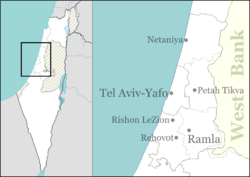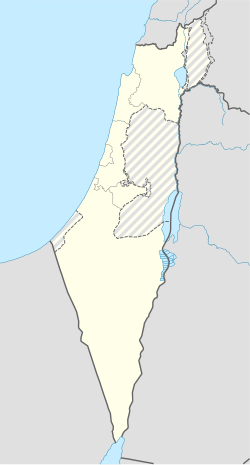Rosh HaAyin
Rosh HaAyin
רֹאשׁ הָעַיִן روش هاعين | |
|---|---|
| Hebrew transcription(s) | |
| • ISO 259 | Roˀš ha ʕayn |
 | |
| Coordinates: 32°05′44″N 34°57′24″E / 32.09556°N 34.95667°E | |
| Country | |
| District | Central |
| Founded |
|
| Government | |
| • Type | Municipality |
| • Mayor | Raz Sagi[1] |
| Area | |
• Total | 24.4 km2 (9.4 sq mi) |
| Elevation | 81 m (266 ft) |
| Population (2022)[2] | |
• Total | 73,678 |
| • Density | 3,000/km2 (7,800/sq mi) |
| Ethnicity | |
| • Jews and others | 99.9% |
| • Arabs | 0.1% |
| Time zone | UTC+2 (Israel Standard Time) |
| • Summer (DST) | UTC+3 |
| Name meaning | Fountainhead |
| Website | www |


Rosh HaAyin (Hebrew: רֹאשׁ הָעַיִן, lit. 'fountainhead', [ˌʁoʃ (h)aˈ(ʔ)ajin]; Arabic: روش هاعين) is a city in the Central District of Israel. In 2022, it had a population of 73,678.[2]
History
[edit]

Rosh HaAyin is named after its location at the source of the Yarkon River (rosh = head, ayin = fountain, spring). The location, and the ottoman Fort that had existed on the site since the 16th century, has historically been referred to as Ras Al-Ayn (Arabic: رأس العين, same meaning as the Hebrew name).[3] There was a Palestinian Arab village with the same in the location, which was destroyed when the Palestinians were forcibly displaced in the 1920s.[4]
Rosh HaAyin was founded in 1949 near the site of ancient Antipatris and the Ottoman fortress of Ras Al-Ayn and on the land of the depopulated Palestinian village of Majdal Yaba, about 1km north of the village site.[5] Many of the early residents were religious Yemenite Jews airlifted to Israel in 1949 and 1950 in Operation Magic Carpet. They added Biblical words from Exodus 19:4 to the city's logo: "I (God) carried You on eagles' wings." The place was one of the Israel Ma'abarot (transit camps) in the 1950s.
In the 1990s, new neighborhoods were built, although the town still has a large Yemeni-Jewish population.
Archaeology
[edit]In 2015, archaeologists discovered a large ancient farmhouse. Among the other artifacts that were exposed in the farmhouse there were two silver coins from the fourth century BCE that bear the goddess Athena and the Owl of Athena. In addition, a monastery dating to the Byzantine period was discovered on one of the hills in the area and included a church, an oil press, residential quarters, and stables equipped with mangers and troughs, etc. In the church were colorful mosaics and also numerous Greek inscriptions.[6]
Demographics
[edit]According to the Israel Central Bureau of Statistics (CBS), in 2018, the ethnic make-up of the city was 97.9% Jewish, with a predominant number of young people below the age of 19. The population growth rate was 9.7% at the end of 2019.[7]
| Age | Percentage (%) |
|---|---|
| 0-4 | |
| 5-9 | |
| 10-14 | |
| 15-19 | |
| 20-24 | |
| 30-44 | |
| 45-59 | |
| 60-64 | |
| 65+ | |
| Total |
Economy
[edit]

According to the CBS, there were 10,972 salaried workers and 1,033 self-employed in 2000. The mean monthly wage for a salaried worker was NIS 6,595, an increase of 11.2% over the course of 2000. Salaried males had a mean monthly wage of NIS 8,408 (a real change of 7.8%) versus NIS 4,857 for females (a real change of 13.1%). The mean income for the self-employed was 6,853. 628 people received unemployment benefits, and 1,057 received an income supplement.
In 2004, the Givot Olam Oil company discovered oil at the Meged 5 oil field near Rosh HaAyin.[8][9] It is one of the largest on-shore oil fields in Israel. It began production in 2010, and produces oil as well as some natural gas. Its proven oil reserves are about 1,525 million barrels (242.5×106 m3).[10] TTI Telecom is located in Rosh HaAyin.[11]
Education
[edit]According to the CBS, there are 24 schools in Rosh Ha'ayin, with an enrollment of 8,288. Eighteen were elementary schools, with an enrollment of 5,043, and high schools, have an enrollment of 3,245. In 2001, 58.8% of Rosh Ha'ayin's 12th grade students were entitled to a matriculation certificate.[citation needed]
| Total Schools | Elementary Schools | Pupils | Elementary Pupils | Post Primary Pupils | Number of Classes | Average student per class |
|---|---|---|---|---|---|---|
| 24 | 18 | 8,288 | 5,043 | 3,245 | 303 | 27.4 |
High schools
[edit]- Atid Religious' boys High School
- Yehuda Halevi-Begin High School
- Darchei Elisha religious' boys high school
- Zvulun religious' girls high school
Sports
[edit]S.C Rosh Ha'ayin ("Moadon Sport Rosh Ha'ayin"), a football team who plays at "Liga Gimel Sharon".
Ironi Rosh HaAyin is a professional beach soccer team based in Rosh HaAyin, Israel.
Transportation
[edit]Public Transportation
[edit]The city of Rosh HaAyin is served by Afikim and Egged bus companies. These bus companies, especially Afikim, serve internal transit, and they connect Rosh HaAyin to nearby towns such as Kafr Qasim and Petah Tikva, to Tel Aviv, as well as along Highway 5 to the settlement of Ariel in the West Bank. The city is served by Rosh HaAyin North railway station, located Northwest of the city. Herzliya–Ashkelon line runs through this station, and it connects Rosh HaAyin to Herzliya in the Northern direction, and to Petah Tikva, Tel Aviv, and Ashkelon in the Southern direction.
Roads
[edit]The city is located at the interchange between Highway 6 (Trans-Israel Highway) and Highway 5 (Trans-Samaria Highway). Westbound Highway 5 provides connections to North-South thoroughfares that connect to localities in the Tel Aviv Metro Area. Eastbound Highway 5 crosses into the Occupied West Bank, passing through Kafr Qassem/Kafr 'Ein Checkpoint. This highway provides connections to several settlements such as Ariel. Southbound Highway 6 provides connections to Jerusalem, Ben Gurion Airport, and further south to Beersheba. Northbound Highway 6 provides connections to Haifa and Galilee.
Route 444 connects the city to its southern neighbors like El'ad and its northern neighbor Jaljulia. Route 483 connects Rosh HaAyin to Petah Tikva to the west.
The city is also collected to Kafr Qassem via a bridge over Highway 5.
Airport
[edit]The closest major airport to the city is Ben Gurion Airport near Lod. The airport is located about 25km to the South, accessible via Highway 6.
Notable people
[edit]
- Nadav Argaman (born 1960), former head of Shin Bet (Israel Security Agency)
- Eitan Cabel (born 1959), politician
- Sagiv Cohen (born 1987), footballer
- Omer Danino (born 1995), footballer
- Gal Gadot (born 1985), actress, producer, model, and former Miss Israel
- Benny Gantz (born 1959), former Chief of General Staff of the Israel Defense Forces; former Minister of Defense and Deputy Prime Minister
- Odelya Halevi (born 1989), actress
- Yishai Levi (born 1963), singer
- Omer Peretz (born 1990), footballer
- Tom Reuveny (born 2000), Olympic champion windsurfing sailor
Twin towns – sister cities
[edit] Kiryat Bialik, Israel
Kiryat Bialik, Israel Hurfeish, Israel
Hurfeish, Israel New Orleans, United States
New Orleans, United States Birmingham, United States
Birmingham, United States Prague 1, Czech Republic
Prague 1, Czech Republic Odesa, Ukraine
Odesa, Ukraine Vanves, France
Vanves, France Cixi, China
Cixi, China
Gallery
[edit]-
Entrance of Rosh HaAyin city
-
A close look at Khalat-as-Sahrij
-
Hurvat Teena a Archaeological Site
-
Khibet Umm el-Hamam, a ruin on southern outskirts of Rosh Ha-Ayin, Israel.
-
A stone structure with water at Hurvat Teena
-
Albom Synagogue at Rosh HaAyin, Petah Tikva (sub-district), Central District, Israel
-
Afek Tower in Rosh HaAyin.
-
A pavilion left over from the British military, (now, Yemenite Jewish heritage house).
-
Lake of Sounds, in Rosh HaAyin
-
Aerial view of Rosh HaAyin, (2017)
-
War Memorial in Rosh HaAyin
-
Rosh HaAyin, the city of music. Square of Notes (Israel Primo Sculpture)
-
Sounds Lake, Rosh HaAyin
References
[edit]- ^ רז שגיא נבחר לראשות העיר ראש העין (28 February 2024). "רז שגיא נבחר לראשות העיר ראש העין". Ynet (in Hebrew).
- ^ a b c "Regional Statistics". Israel Central Bureau of Statistics. Retrieved 21 March 2024.
- ^ Karmon, 1960, p. 171
- ^ Khalidi, W. (1992). All That Remains: The Palestinian Villages Occupied and Depopulated by Israel in 1948. Washington D.C.: Institute for Palestine Studies. ISBN 978-0-88728-224-9., p. 396
- ^ Khalidi, W. (1992). All That Remains: The Palestinian Villages Occupied and Depopulated by Israel in 1948. Washington D.C.: Institute for Palestine Studies. p. 397. ISBN 0-88728-224-5.
- ^ Ancient farmstead and monastery exposed in Rosh Ha-‘Ayin
- ^ a b c "קובץ הרשויות המקומיות בישראל - 2018". www.cbs.gov.il (in Hebrew). Retrieved 2021-06-08.
- ^ "חדשות כלכלה, בורסה וצרכנות מהארץ והעולם - דה מרקר". TheMarker. Retrieved 2016-07-12.
- ^ Zeno, Lior (22 September 2010). "Givot admits: We can't estimate scope of oil reserves at Meged-5". Haaretz. Retrieved 2016-07-12.
- ^ "Gevaot Olam: Meged 5 Oil Field Has 1.5 Billion Barrels". Arutz Sheva. August 17, 2010. Retrieved 1 January 2011.
- ^ Your Taxes: Israeli firm wins Indian tax case

















